


For the fourth time within the past year, port truck drivers have struck short-distance hauling companies over a list of unfair labor practices that include low pay and the endemic misclassification of drivers as “independent contractors.” Misclassification has condemned drayage employees who work at the Ports of Los Angeles and Long Beach to a status of modern serfdom. Port drivers often work 16 hours a day and are financially responsible for the fueling and upkeep of their high-maintenance vehicles – yet their take-home checks can amount to less than minimum wage, thanks to company deductions that charge drivers for everything from gas to insurance.
The strike began early Monday, when drivers who work for Green Fleet Systems (GFS), Total Transportation Services, Inc. (TTSI) and Pacific 9 Transportation (Pac 9) began picketing the companies’ truck yards, as well as the marine terminals of the two giant ports, which receive 40 percent of the nation’s imports.



“When you’re in Mississippi the rest of America doesn’t seem real. And when you’re in the rest of America, Mississippi doesn’t seem real. ”
— Bob Moses, Mississippi Freedom Summer Director
The Mississippi Freedom Summer project of 1964 was born of necessity. The ranks of civil rights workers in the state were being devastated and the nation needed to pay attention. The proposal to bring hundreds of college students into Mississippi for the summer to work as voter registration and Freedom School volunteers was controversial. Opponents worried that the mostly white students didn’t know the state, might distract from building grassroots leadership and could provoke even more retaliation from Mississippi segregationists. But according to civil rights veterans who convened the 50th Anniversary gathering of Mississippi Freedom Summer in Jackson this past June, it was the local leaders, like former sharecropper Fannie Lou Hamer,



“It’s always darkest before the dawn” sang Pete Seeger. “And that’s what keeps me moving on.”
The recent spate of reactionary decisions by the Roberts Supreme Court — including this week’s outrageous Hobby Lobby ruling — triggers thoughts of a better day, when the right-wingers on the court will have retired or died, replaced by thoughtful liberals who will restore some semblance of fairness and democracy to this great country. Let’s consider what it would be like if our nation’s highest court was actually committed to the notion of “liberty and justice for all.”
Doing so requires making a few leaps of faith, but none of them are far-fetched. It depends on the outcome of the next few election cycles.
If the Democrats retain a majority in the Senate after this November, the feisty, brilliant Ruth Bader Ginsburg, now 81 years old, should retire so Obama can appoint another (younger) liberal member who will have a long tenure on the court.
Film director Randall Miller (Bottle Shock), along with Jody Savin and Jay Sedrish, the producers of the ill-fated Gregg Allman biopic, Midnight Rider, have been indicted on charges of involuntary manslaughter and criminal trespass, the Hollywood Reporter and other sources reported Thursday morning. The charges were filed in a superior court in the state of Georgia, where a February 20 accident killed camera assistant Sarah Jones.
The 27-year-old Jones’ death occurred when a freight train unexpectedly rolled through a scene being staged on railroad tracks in the small town of Doctortown Landing. Her death, which became a cause celebre among Hollywood safety activists, threw a spotlight on the dangers faced by below-the-line crew members as production companies large and small have taken shortcuts to keep down costs. With producers – particularly those involved in reality TV shows –increasingly adopting an accidents-will-happen attitude toward the safety of their crews,



Our friends at Labor 411 continue to offer ways to celebrate holidays and support good American jobs at the same time. This week, of course, the 411 folks are highlighting the Fourth of July. They begin with Old Glory itself – noting that of all the flag versions (foreign and domestic) sold in America, you can’t do better than ones produced by the union workers of Annin Flagmakers (United Food and Commercial Workers) or Artflag (Workers United).
Doubling down on the red, white and blue spirit, Labor 411 suggests stocking up on like-colored edibles, quaffables and utensils, including:
Red: Solo Cups, Red Vines, Coca-Cola, Wine (C.K. Mondavi, Gallo Estate, Turning Leaf), Salsa (Old El Paso, Tostitos, Pace)
White: Popcorn (Act II, Orville Redenbacher, Smartfood), Domino Sugar, Chicken (Foster Farms, Banquet, Tyson), Milk (Alta Dena, Darigold, Horizon)
Blue: Pepsi,
» Read more about: Flagonomics — Supporting Good Jobs With Your Fourth of July Dollars »
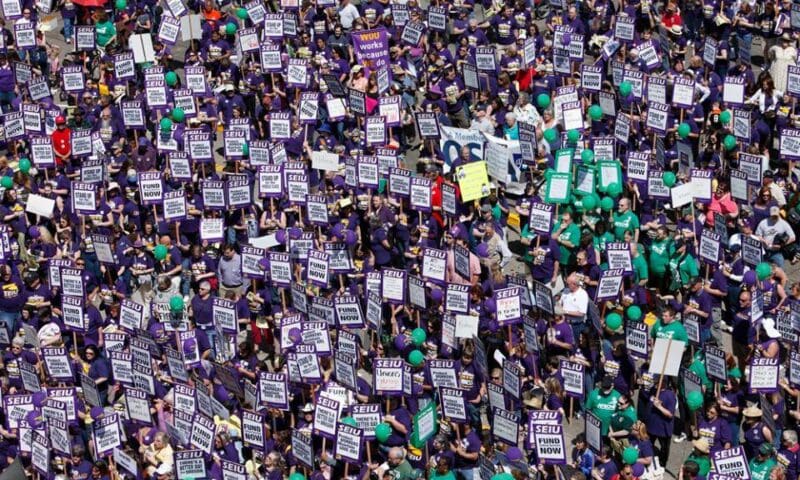


In Harris v. Quinn, the Supreme Court held by a 5-4 margin that an “agency shop” requirement—under which unionized public employees must pay their fair share of the costs of negotiating and administering a collective-bargaining agreement whose benefits they enjoy—may not be imposed on homecare workers who are (in the conservative majority’s view) only tenuously employed by the State of Illinois. Doing so, the conservatives held, violates the First Amendment.
The decision creates real obstacles for homecare workers in Illinois, California and other states who wish to have well-funded, effective unions representing them (and who don’t want to have their colleagues free-ride on the dues they pay to support such unions). This was a serious blow for homecare workers, but the obstacles are ones that can be overcome.
The bigger story of Harris v. Quinn is what didn’t happen: the conservative justices did not end fair-share fee arrangements altogether for public-sector workers.
» Read more about: Why Harris v. Quinn Is No Sweeping Victory for Conservatives »


Technology is radically transforming the ways we work and the ways we learn, nowhere more so than in the world of online education. But will the shape of the future be drawn solely by corporate leaders in the technology industry, or will parents, students and teachers have a voice in what tomorrow’s digital classroom looks like?
As the online education sector grows, the public’s stake in that question becomes ever more paramount. One way in which virtual teachers are seeking to ensure that the pursuit of profits does not come at the expense of students, parents and educators is by organizing to join the California Teachers Association. (Disclosure: CTA is a financial supporter of Capital & Main).
Below is the first in our series of posts written by teachers at the California Virtual Academies (CAVA), an affiliate of K12, a for-profit,
» Read more about: Lesson Plan: Protecting Students In Online Schools »
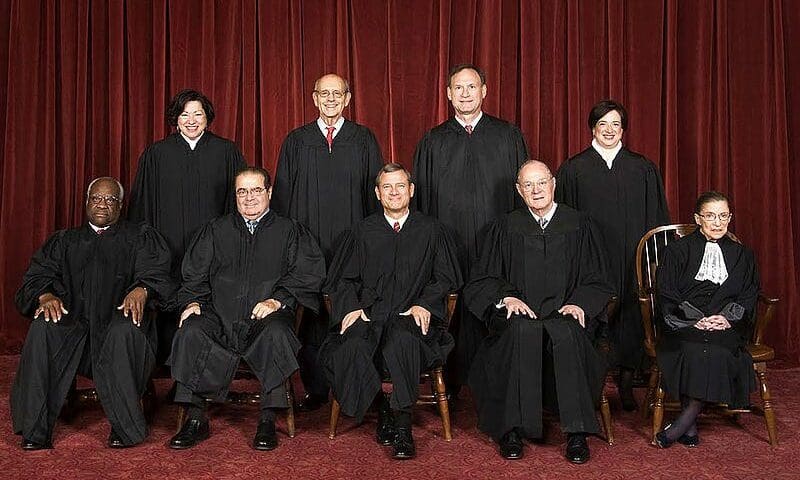

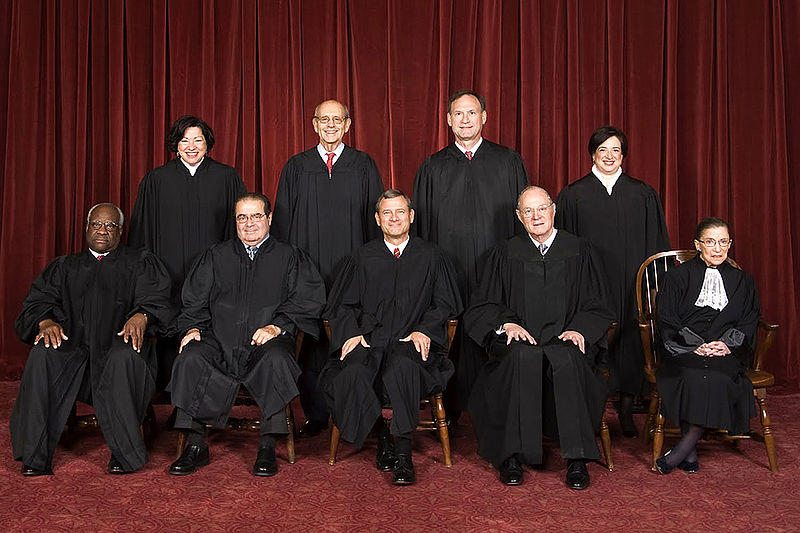
(Editor’s Note: Richard Kirsch’s feature first appeared on the Roosevelt Institute’s Next New Deal blog, as well as on Huffington Post. It is cross-posted here with the author’s permission.)
A huge sigh of relief mixed with curses. That’s my reaction to the Supreme Court’s decision today to block home care workers in Illinois from being required to pay union dues, while continuing to allow public employee unions to collect dues from all the workers they represent. The decision in Harris v. Quinn blocks the right-wing assault against one of the most important pillars of progressive infrastructure, public employee unions, but will add to the challenge of raising wages and benefits in the surging low-wage workforce.
First, some background on the case: As part of the right’s ongoing attack on working people, a right-wing legal group recruited a handful of home care workers in Illinois to challenge the state’s requirement that the workers pay union dues.
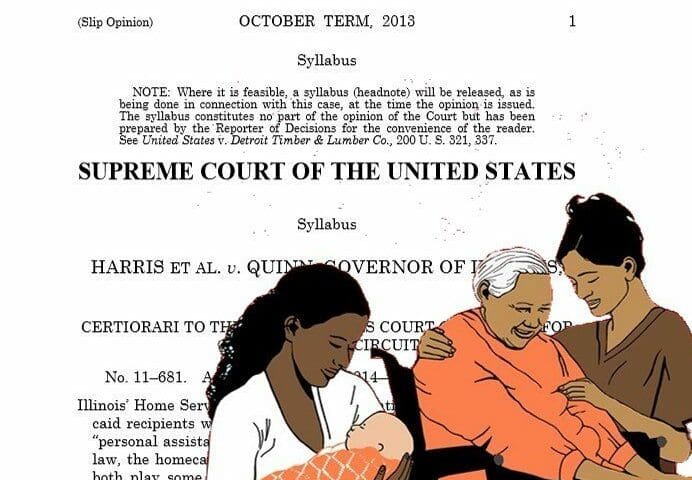

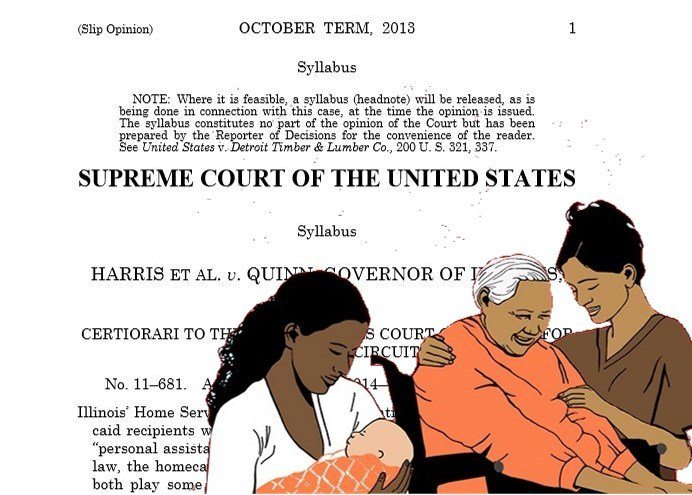
Monday’s U.S. Supreme Court ruling in Harris v. Quinn, which settled an Illinois lawsuit filed by the National Right to Work Foundation, did not strike down the ability of all public employee unions to collect fees from workers. It did, however, appear to create a new class of worker – the “partial public employee” – that could seriously hinder those unions’ organizing efforts.
While it remains to be seen exactly how the court’s decision will play out in the months to come, California in-home caregivers and organizations that represent them and their clients vowed today to carry on with their work. On a teleconference held within hours of the court’s ruling, representatives of unions and care recipients spoke of the importance of unions in the transmission of home health care.
“Homecare workers are a classic example of a workforce that needs to bargain collectively,” said Gary Passmore,
» Read more about: After the Harris Ruling: Home-Care Workers Will Continue to Organize »



In a closely watched decision, the U.S. Supreme Court this morning ruled that home-care workers cannot be compelled to pay fees to the unions that represent them. The ruling in the Harris v. Quinn case was narrow in its scope — there had been speculation that a majority of the justices could throw out the high court’s 1977 Abood decision that had authorized all public-sector unions to collect dues from workers for whom the unions negotiated contracts.
According to the Los Angeles Times:
In a 5-4 ruling written [by] Justice Samuel A. Alito Jr., the court said these employees, some of whom care for their disabled children at home, have a constitutional right not to support a union they oppose. The decision is a victory for the National Right to Work Foundation, which took up the cause of several mothers who objected to paying union fees.